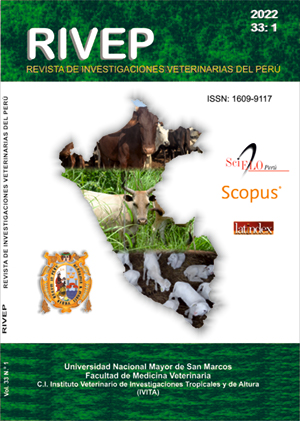Non-human primate diets in the northern Peruvian Amazon
DOI:
https://doi.org/10.15381/rivep.v33i1.22159Keywords:
feeding ecology, food diversity, trophic niche breadth, stomach contents, seed dispersal, AmazonAbstract
There are few studies describing the eating habits of non-human primates (NHPs) that provide information related to the use of food resources of the ecosystem in the Amazon Forest. The objectives of the study were (1) to determine the composition of the diet of six species of NHPs and (2) to evaluate the amplitude and diversity of their diets from the evaluation of the gastric contents of animals hunted for subsistence purposes by inhabitants of three areas of the northern Peruvian Amazon between 2012-2015. Samples of 82 primates of the species Lagothrix poeppigii (n = 30), Sapajus macrocephalus (n = 23), Pithecia monachus (n = 11), Cacajao calvus (n = 8), Cebus albifrons (n = 6) and Alouatta seniculus (n = 4). The NHPs diet consisted of a high variety of fruits, including 133 types of seeds and 39 types of arthropods. The amplitude of the niche according to the Levin Index and the Simpson Diversity Index indicate that L. poeppigii is the most generalist species in terms of fruits and arthropods, followed by C. calvus with arthropods and by S. macrocephalus in the use of fruits. On the contrary, Cebus albifrons is the most specialized species when it comes to fruits and P. monachus when it comes to arthropods.
Downloads
Downloads
Published
Issue
Section
License
Copyright (c) 2022 Reyna Isabel Castilla Torres, Anamélia de Souza Jesus, Juan Olazabal Loaiza, Pedro Mayor

This work is licensed under a Creative Commons Attribution 4.0 International License.
AUTHORS RETAIN THEIR RIGHTS:
a. Authors retain their trade mark rights and patent, and also on any process or procedure described in the article.
b. Authors retain their right to share, copy, distribute, perform and publicly communicate their article (eg, to place their article in an institutional repository or publish it in a book), with an acknowledgment of its initial publication in the Revista de Investigaciones Veterinarias del Perú (RIVEP).
c. Authors retain theirs right to make a subsequent publication of their work, to use the article or any part thereof (eg a compilation of his papers, lecture notes, thesis, or a book), always indicating the source of publication (the originator of the work, journal, volume, number and date).










